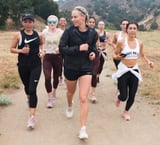
It was after my longest run ever - 12 miles, at that point - that I got the hunch I messed up. The last two or three miles were a harder slog than they should have been; I felt like I needed a boost to snap me out of my physical fatigue and mental grogginess. I set out hydrated and well-rested and didn't have any nagging injuries. I also set out with nothing but a double espresso in my stomach and didn't consume any calories during the run. Rookie mistake.
My fueling fail prompted me to ask my coach, Bec Wilcock, to share the nuts and bolts on what to eat and when to eat on a distance run. Coach Bec is training my Nike Women's Marathon Project team (mercilessly, I might add) for the Chicago Marathon. Her own credentials are impressive: she's a seasoned ultramarathoner and all-around powerhouse who knows a thing or two about keeping your body fueled to tackle major tests of endurance.
Here's the simple science behind why it's vital to refuel mid long run: your body needs glucose (sugar) to burn. If it doesn't have it, it will move onto your body's glycogen stores. Our livers and muscles store glycogen, and once the muscle's stores are depleted, extreme physical fatigue - or "bonking," in runner's parlance - sets in. Read on for Coach Bec's advice on how to figure out what fueling plan works for you.


0 comments :
Post a Comment